ganymede
[ + link to: What to see on Ganymede ]
Here's a glorious arena for Old Solar System science fiction: a world larger than Mercury, with its own mystery and potential.
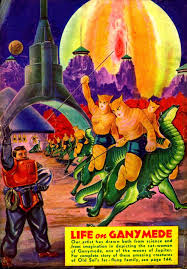 by Frank R Paul
by Frank R PaulStid: But you're in a cleft stick, Zendexor.
Because nothing was known, in pre-probe days, about the surface of Ganymede, writers didn't even have the false clues on which to build a tradition, that Mars had with its Lowellian "canals", or Mercury with its supposed Twilight Belt.
That being so, Ganymede was a mere blank slate for writers. You could invent what you liked about the place. And therefore, no archetypal picture could evolve, to give shape to the literary history of that world.
I know how much you like to trace patterns, to explore the main line of tradition that shapes the fictional character of a world. But I don't see how you're going to set about doing that here. All you've got to work with is a bunch of random imaginings.
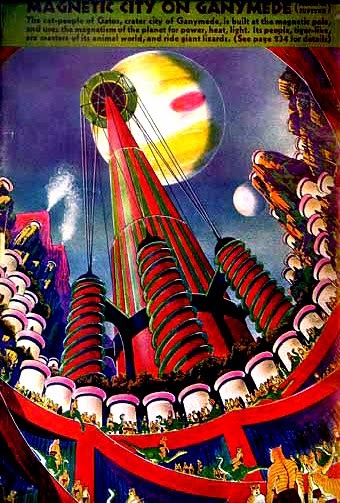 by Frank R Paul
by Frank R PaulZendexor: I think you're forgetting that we - or at least, I - have already dealt with that point in the general page on the Galilean Satellites.
I'm not going to argue it out again - I am simply going to demonstrate that Ganymede does have its own planetary personality.
Or rather, I have faith that the stories I cite shall do my job for me. They shall manifest an emergent idea, over and above their separate selves.
Let's sniff, then, what vapour rises when I concoct a brew from Seeding Program, Farmer in the Sky, Spacehounds of IPC, Derelict and The Dancing Girl of Ganymede.
Stid: This I've got to see. If you can link all those, my name's Captain Future. What possible theme can you find to connect the bleakly hostile environments of Seeding Program and Farmer in the Sky on the one hand, and the teeming world described in the other three stories?
Zendexor: You yourself have made a start for me, by linking the first two - the bleak Ganymedes.
pantropy
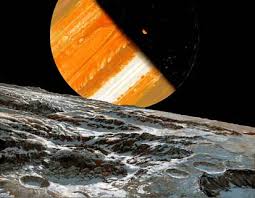
The starkest is the Ganymede of Seeding Program. It's a world as hostile as the Moon, or more so - with a "thin stink" of atmosphere, and temperatures so low that any creature living there would need to use liquid ammonia for blood.
But that's the point - the hero, Donald Sweeney, does have that kind of blood.
Sweeney was an Adapted Man... The blood that ran in his veins, and the substrate of his every cell, was nine-tenths liquid ammonia; his bones were Ice IV; his respiration was a complex hydrogen-to-methane cycle based not upon catalysis by an iron-bearing pigment, but upon the locking and unlocking of a double sulphur bond; and he could survive for weeks, if he had to, upon a diet of rock-dust.
All this is the result of bio-engineering techniques collectively termed "pantropy" - a word coined by James Blish, the author of this story. Loosely translated "pantropy" means "changing everything".
Blish gives us some details of the process, instead of just having it all happen at the press of a button of a "matter converter" as in Simak's Desertion. But in either tale, what counts is the emotional as well as the physical result. Upon reaching the destination for which he has been designed, Sweeney finds he likes being out in the open in the bitter cold of Ganymede.
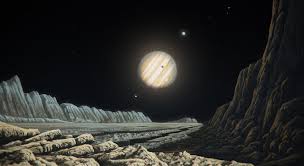
For the first time in his life he had walked unguarded, either by men or by mechanisms, on a world where he felt physically at home; a world without walls... The air was rich and pleasant, the winds came from wherever they chose to blow... and there was sky all around him, tinged with indigo and speckled with stars...
You see, the pull begins - the pull towards the idea of Ganymedean life. We're a long way yet from the richness of the Frank R Paul illustrations shown above. But the gap between the bleak and the rich Ganymedes is starting to close.
Stid: Still sounds like a bare world, though. Adapted Men aren't enough to soften the landscape.
Harlei: Unless - is the "pantropy" used to adapt other terrestrial organisms besides humans? I mean, do the authorities create Ganymedean vegetation, for instance?
Zendexor: I note that you, who have read the story, are still uncertain on that point. I know the feeling! Here's what the author tells us, in his somewhat close-packed style - and note that when he refers to "warm weather" and "cold weather" he is doing so in Ganymedean terms, meaning different degrees of what would be unimaginable cold to a normal terrestrial:
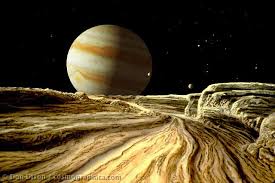
...The wind which blew over the flute-mouthpiece of rock on this side of the mountain was as gentle and variable as a flautist's breath, and did not stir the enormous tangled stolons and runners which filled the bottom of the great valley, or the wrap-around leaves which were plastered to them like so many thousands of blue-green Möbius strips.
It was not quiet down there, but it seemed quiet. There were many more thrums and rummums of rolling rocks and distant avalanches than one heard during the cold weather. The granite-skinned roots were growing rapidly while their short time was come, burrowing insistently into the walls of the valley, starting new trees and new rocks. In the cliffs, the warm weather changed water-of-crystallisation from Ice IV to Ice III, the bound water snapping suddenly from one volume to another, breaking the rock strata apart...
(I had to look up what a stolon is - it's a horizontal branch growing from the base of a plant.) To answer your question, Harlei: my own feeling is, that the author is talking about native Ganymedean life. The Earth authorities didn't need to create a whole ecosystem; they merely introduced Adapted Men into an already living environment. That's how I read it, anyway.
Stid: And whose fault is it, that you're unsure?
Zendexor: I hesitate to blame the author. Blish's work isn't always easy reading for me, but his stuff is powerful, memorable and worth persevering with. And the more I think of Harlei's question the more I feel certain that Blish's Ganymede has its own native life.
...All these incessant erratic rumbles and muted thunders were the sounds of high summer in the Gorge. They were as peaceful to Sweeney's ears as bee-buzz is to an Earthman, though Sweeney had never encountered bee-buzz except in books. And like growing things everywhere, the terrific gnarled creepers down below sent up into the Adapted Men's lair a fresh complacent odour, the specific smell of vegetable battle-unto-death which lulls animal nostrils and animal glands into forgetting past struggles of their own.
All this to me doesn't seem like the useful crops which terrestrial engineers would have prioritized, if they had been responsible for these flora. (Also, see the comments by Dylan in Pinnah-Birds and Genetic Engineering.)
terraforming
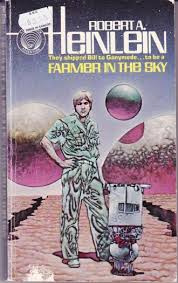
Contrarywise, there is definitely no native life on Heinlein's Ganymede in Farmer in the Sky, where the place is being terraformed.
The colonist-narrator sees the effect of this during his approach from space:
Ganymede was straight ahead, almost, and growing all the time - and here was a funny thing; Callisto was silvery, like the Moon, but not as bright; Io and Europa were bright orange, as bright as Jupiter itself. Ganymede was downright dull!
I asked George about it; he came through, as usual. "Ganymede used to be about as bright as Io and Europa," he told me. "It's the greenhouse effect - the heat trap. Otherwise we wouldn't be able to live on it."
I knew about that, of course; the greenhouse effect is the most important part of the atmosphere project. When the 1985 expedition landed Ganymede had a surface temperature a couple of hundred degrees below zero - that's cold enough to freeze the milk of human kindness! "But look, George," I objected, "sure, I know about the heat trap, but why is it so dark? It looks like the inside of a sack."
"Light is heat; heat is light," he answered. "What's the difference? It's not dark on the ground; it goes in and doesn't come out - and a good thing, too."
Stid: Didactic stuff.
Zendexor: And well done, too. But yes, one can tell from the tone that it's one of Heinlein's novels for young-adult readers. The odd thing is, when I recently re-read it to make notes for this page, about half a century after my previous reading, I liked it a lot better than I had done in my young-adult days.
Harlei: I bet that's because in those days it was too prosaic for you. The book's matter-of-fact hero isn't sufficiently awed by his trip to Ganymede and by the new life he starts there, nor is Ganymede itself evoked with much sense of wonder.
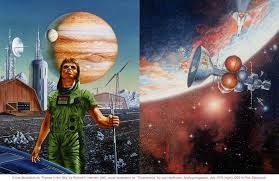
Zendexor: Right - that's the sort of criticism I would have made, back when I was a boy. Not that I didn't enjoy the book, even then - I read it quite avidly, but I felt dissatisfied. I wanted what Heinlein wasn't giving - but nowadays, in retrospect, in view of how much he does give, I'd feel like a nitpicking ingrate if I continued to ask for more. Besides, I've got used to adding the missing ingredients myself. I do this by means of attitude. Noticing aspects of the book which I didn't notice before, I pump new perspectives in.
Harlei: I certainly want to borrow your perspective-pump - if I can figure out how to use it...
Zendexor: Good - that's half the battle: the wanting!
If like a telepathic hound on a trail you were able to follow my thoughts as I progressed through the book, you'd see how desire evokes its object -
Stid: All this glib talk boils down to this: that you read into the book what you want.
Zendexor: With some help from the author and more help from his subject-matter, yes!
Let me explain how it works.
sightseeing
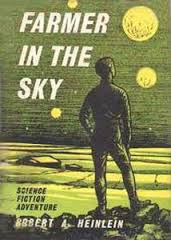
Given that my desire is for a richly unique and character-filled world - it's at first disappointing that Heinlein hardly gives any impression of the Ganymedian landscape. But then I notice that he does take quite a lot of trouble to describe the Ganymedian sky, with the lights and shadows of giant Jupiter and its chasing moons. The practical-minded teenager Bill Lermer is endlessly fascinated by this sky, as well he might be.
He's also keen to explore his adopted world, though for a long time he is too busy working to get the chance. And I, the reader, hope with him, that he will get that chance. This is an instance of how, in a supposedly "prosaic" book, both author and theme are great enough to respond to the pull of other yearnings...
Ganymede had to have settlements other than Leda; that was evident even when we landed. The Commission planned to set up two more ports-of-entry...
The old Jitterbug was about to take pioneer parties out to select sites and make plans - and both Hank and Sergei were going.
I wanted to go so badly I could taste it. In the whole time I had been here I had never gotten fifty miles from Leda. Suppose somebody asked me what it was like on Ganymede when I got back to Earth? Truthfully, I wouldn't be able to tell them; I hadn't been any place.
So he's determined to explore - the reader's heart beats faster - so maybe now at last we'll do some real Ganymedean sightseeing...
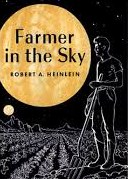
Previous to this, the closest the author gets to giving us a proper taste of that world is at one point on page 124 when the narrator is depressed by the hardness of pioneer life:
...It had been snowing and it was already almost pitch dark, though the Sun hadn't been down more than a couple of hours. The snow had stopped but there were clouds over head and you couldn't see Jupiter.
The clouds had broken due west and let the sunset glow come through a bit. After my eyes adjusted, by that tiny amount of light I could see around me - the mountains, snow to their bases, disappearing in the clouds, the lake, just a sheet of snow-covered ice, and the boulders beyond our fields, making weird shapes in the snow. It was a scene to match the way I felt; it looked like the place where you might be sent for having lived a long and sinful life.
Bleak and cold, but at least it had some feel to it. And now some time has gone past and Lermer is on the survey team, doing some real exploring, the world will surely, surely - pants the reader - surely yield up some more of it's personality, won't it?
And guess what - it does happen, in the last twelve pages of the book!
I won't say how, but if you read it you will see that the question of Ganymedean life is re-opened. Maybe not with native life, but with something - we are not told, we are shown a mystery.
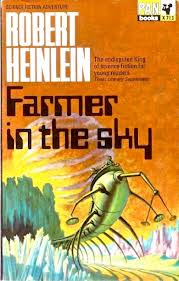
Stid: In the last twelve pages of the book, eh?
Zendexor: Don't sound so censorious. It's not a condemnation of the book to say that it turns into a classic planetary adventure in the last twelve pages. It would be a condemnation if classic planetary adventure was what it was supposed to be about, or if this page purported to be a balanced critique of Farmer in the Sky, but neither of those propositions is true.
I'm just looking at it from one particular angle, and so I focus upon the one point of contact between what interests me and what Heinlein provides. There is a link, a thematic gateway, opening in those last dozen pages. Through it a new light floods back over all the previous chapters of the book. Chapters which were great explorations of practical life, of the details of colonization - but now they can happily exist as a prelude.
Stid: Prelude to what?
Zendexor: Prelude to what we see in the picture here. Like I said, I'm not giving the story away.
Stid: All the same, you've admitted that the main thrust of Heinlein's book is to do with nuts-and-bolts colonizing, not exploration or aliens or derring-do. In fact, to me, that's the appeal of Farmer in the Sky: it is so realistic. Realism in the Sky: an attractive yarn of everyday adventure.
castaways
And now I think you're facing the moment, Zendexor, when you're going to feel obliged to tie in this serious account of terraforming and colonization with a completely different kind of story.
Zendexor: Nothing to it! I'll do it with multi-leggedness.
Stid: Eh?
Zendexor: You see, Stid, it's no use pointing out to me what the "main thrust" of a book is, if I'm in the mood for really agile tie-ins.
All I need do is point to the cover illustration above, with its multi-legged alien transporter, and then, in a sort of ideological rhyme, turn to an example of multi-leggedness in another story:
...Wild animals he had supposed them, but as he stood firm and raised his weapon shrill whistles sounded in the throng and he gasped as he realized that those frightful creatures must be intelligent beings, for not only did they signal to each other, but he saw that they were armed with bows and arrows, spears, and slings!
Six-limbed creatures they were, of a purplish-red colour, with huge, tricornigerous heads and with staring, green, phosphorescent eyes. Two of the six limbs were always legs, two always arms; the intermediate two, due to a mid-section jointing of the six-foot-long, almost cylindrical body, could be used at will as either legs or arms. Now, out of range, as they supposed, they halted and gathered about one who was apparently their leader; some standing erect and waving four hands while shaking their horns savagely in Stevens' direction, others trotting around on four legs, busily gathering stones of suitable size for their vicious slings.
[Spacehounds of IPC, page 65]

For me there is a special charm about chapters 3 and 4 of Spacehounds of IPC - the episode during which the hero and heroine, Stevens and Nadia, are castaways on Ganymede.
It's classic Old Solar System stuff. The OSS was so roomy. In those days, fortune-tossed individuals could discover big things. You could be on a space-liner unexpectedly attacked by Jovians (hitherto unknown) and escape in an improvised lifeboat (dubbed the Forlorn Hope) to Ganymede (never before visited by Terrans) and hope to find it habitable. Backtracking to their arrival:
...Stevens headed for the morning zone and dropped the Hope rapidly towards the surface of that new, strange world. Details could not be distinguished at first because of an all-enshrouding layer of cloud, but the rising sun dispelled the mist, and when they had descended to within a few thousand feet of the surface their vision was unobstructed. Immediately below them the terrain was mountainous and heavily wooded; while far to the east the rays of a small, pale sun glinted upon a vast body of water. No signs of habitation were visible as far as the eye could reach.
Doc Smith often writes crudely but he hacks out his sentences with great spirit. Also, during this period of his career (the 1930s), he wrote with old-fashioned idealism of the relations between man and woman. No one would write that way now, because no one would believe it now. It's pleasant to recall the vanished literary universe in which decency was possible. Not that it's easy for the stranded couple - they love each other passionately, but there is no one to conduct a wedding service on Ganymede. Stevens the engineer and jack-of-all-trades feels the pressure is on him to achieve the impossible in order to get back to civilization:
"...the first thing I've got to do is to build a power plant. I'm going to run a penstock up those falls and put in a turbine, driving a high-tension alternator. Then, while I'm trying to build the ultra-radio, I'll be charging our accumulators, so that no time will be lost in case the radio fails...
"It's going to be a real job - I'll not try to kid you into thinking it'll be either easy or quick. Here's the way everything will go. Before I can even lay the first length of the penstock, I've got to have the pipe - to make which I've got to have flat steel - to get which I'll have to cut some of the partitions out of this ship of ours - to do which I'll have to have a cutting torch - to make which I will have to forge nuzzles out of block metal and to run which I'll have to have gas - to get which I'll have to mine coal and build a gas-plant - to do which..."
In many respects their life as castaways on Ganymede is an idyll, but Nadia eventually sees that Stevens is destroying himself with overwork:
In the brief period of rest following a noonday meal, Stevens lay flat upon the warm, fragrant grass beside the Forlorn Hope; but it was evident to Nadia that he was not resting. His burned and blistered hands were locked savagely behind his head, his eyes were closed too tightly, and every tense line of his body was eloquent of a strain even more mental than physical. She studied him for minutes, her fine eyes clouded, then sat down beside him and put her hand upon his shoulder.
"I want to talk to you a minute, Steve," she said gently.
"All x, little fellow - but it might be just as well if you didn't touch me. You see, I'm getting so that I can't trust myself."
"That's exactly what I want to talk to you about..."
In a passage which I am not at all inclined to sneer at, she brings their feelings for each other out into the open, and then reassures him:
"...Can't you see that there is no need of uncertainty between you and me? That there is no need of you driving yourself to desperation on my account? ... If you can build everything you need, all well and good. We'll be engaged till then... If worst comes to worst, and we can neither communicate with Brandon and Westfall nor leave here under our own power - even that is nothing to kill ourselves about. And yes, I do know exactly what we are facing. I have been prepared for it ever since I first saw what a perfectly impossible thing you are attempting. You are trying to go from almost the Age of Bronze clear up to year-after-next in a month or two... and I do not see how even you, with what little you have to work with, can possibly build such things as power-plants, transmitters, and ultra-radio stations. But what of it? For the day that it becomes clear that we are to remain here indefinitely; that day we will marry each other here, before God. Look around at this beautiful country. Could there be a finer world upon which to found a new race?..."
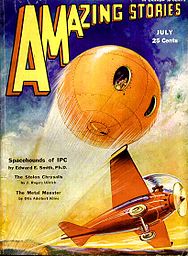
The fact that they have enemies which make it essential for them to escape from Ganymede after only two chapters does not erase the memory of that idyll in the reader's mind.
Enemies... enemies... that's the link to the next story on our Ganymede-crawl, as we turn to another 1930s tale.
In Derelict the scene of the action is out in space, but memory and vision are focused on the Jovian moon.
charged world
Pictures appeared on the screen - bleak, rolling desert and tortured gorges. Then an oasis where there was water, and where the radioactive ores underground provided enough heat to permit the growth of vegetation. At its center was a little rough city under a crystal dome. Joraanin, the Ganymedean colony!
Around it men and loyal Loathi were entrenched, fighting off hordes of rebel Loathi that circled on batlike wings above, their long beaks gleaming. The revolt was still in progress. A strong hand was needed there to end this chaos and death...
And that's about it, that's almost all we're shown of Ganymede in this story. A few pages earlier, the hero does dream of
A jagged mountain jutting out of the red desert of Ganymede.
Mere fragments; yet the memories are strong, and they colour the story.
A link, by the way, between this Ganymede and the previous version: internal radioactive heat. Stevens in Spacehounds of IPC replies when Nadia asks him why the place is warm:
Our heat here is probably caused by radioactivity...
Stid: Don't tell me, I can guess, you're going to round off this page by saying that Leigh Brackett likewise has the same explanation for the warmth of her Ganymede.
Zendexor: I don't have to go that far. All I have to do - to make the link - is point out that she, like the other authors, feels she has to address the issue of temperature somehow.
She does it in a different way - by reference to volcanism.
Here's the beginning of The Dancing Girl of Ganymede:
Tony Harrar came into the bazaar of Komar, heading for the Street of the Gamblers. The sour wine was heavy in him and his pockets were light and he was in no hurry. Win or lose, there was nothing to be in a hurry about. He was on the beach and Komar is a far lost beach for an Earthman.
The wind blew slowly through the narrow streets, stirring the torch flames that burned eternally under the dim red sky. It smelled of heat and sulphur, of the volcanic heart of Ganymede. Even here on the plateau, a thousand feet above the jungle, there was no escape from it. The sliding roofs of the houses were open wide to receive it for there was no other breath of air.
Above the tumult of the bazaar the great yellow star that was the Sun blazed splendidly in the far darkness of space. Jupiter filled half the sky, misty, banded with crimson and purple and grey. Between Sun and Jupiter raced the thronging moons, catching light now from one, now from the other, burning, flashing, glorious.
Furry aboriginals, humanoid but not human, live down in the jungle of Brackett's Ganymede. Nothing like the dangerous batlike Loathi of Gallun's version or the murderous hexans of Doc Smith's.
But the reader is used to parcelling it all up under a sub-genre heading, "Ganymede". And how is this done?
Stid: Rhetorical question, Zendexor. You're going to say that you accomplish the feat automatically by gathering all the tales with the unifying tentacles of your octopuslike imagination.
Zendexor: Using the name they all have for the moon, you proceed, from that point of unity, to gather other link-points: the common location in the Jovian system, the special sky, the need for heat - volcanism or radioactivity; the story's need for enemies or challenges or crises for drama's sake; the sense, perhaps, that one has reached a special frontier, the beginning of the outer solar system.
And that phrase "outer solar system" reminds me: the spores of intelligent plant life in Seeds of the Dusk orginated somewhere out there; those spores which, over the aeons, drifted sunwards from world to world. And which is the outermost and earliest habitation of these beings that is mentioned in the story? I'll give you one guess. Admittedly they had come there from even further out, but Ganymede is the furthest place named.
...probing out across the desert, slowly building - with hollow, connecting roots - the water pipes of a tremendous irrigation system. Like that of Mars, and like that of Ganymede, moon of Jupiter, in former ages.
In short, if you plug into the concept "Ganymede" you'll find that the battery has been charged.
James Blish, "Seeding Program" (originally appeared in The Magazine of Fantasy and Science Fiction (February 1956) as "A Time to Survive", then in The Seedling Stars (1957)); Leigh Brackett, "The Dancing Girl of Ganymede" (Thrilling Wonder Stories, February 1950); Robert A Heinlein, Farmer in the Sky (1950); Raymond Z Gallun, "Derelict" (Astounding Stories, October 1935); "Seeds of the Dusk" (Astounding Science Fiction, June 1938); Clifford Simak, "Desertion" (Astounding, November 1944); E E "Doc" Smith, Spacehounds of IPC (1931, 1947)
See also the page on primordial worlds for a reference to ancient Ganymede.
For a brief note on a watery Ganymede, see the Stanley G Weinbaum page.
Pinnah-Birds and Genetic Engineering argues for a variety of Ganymedean life.
For a transitional OSS/NSS Ganymede as imagined in 1977, two years before Voyager, see the OSS Diary for 9th January 2017.
For the grassy-swampy Ganymede of Murray Leinster's Space-Can, see the Diary,
Bellyaching Spacemen, and the following entry, Ganymede as a Frontier.
For a synthesis of "wet Ganymedes", try overlapping the Weinbaum and Leinster imaginings mentioned above.
For thoughts on Ganymede's surface gravity, in Heinlein's Farmer in the Sky and in actual fact, see the Diary, 9th January 2018.
For a giant native creature see Ganymedean Colossus.
The task of giving Ganymede a cultural personality is discussed in the letters page of the September 2019 Tales To Astound.







































